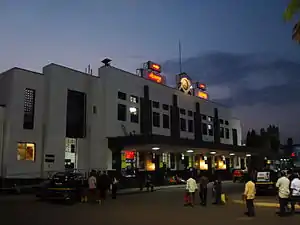Solapur railway station
Solapur JN railway station is located in Solapur district in the Indian state of Maharashtra and serves Solapur city and the industrial belt around it. It is headquarters of Solapur Railway Division and a part of Central Railway zone. It is the 4th cleanest and one of the Beautiful railway station in India ranked A-1 among 500 main stations in India.
Solapur JN | |
|---|---|
| Indian Railways station | |
 Station entrance | |
| Location | Station Road, Solapur, Maharashtra India |
| Coordinates | 17°39′50″N 75°53′35″E |
| Elevation | 455.000 metres (1,492.782 ft) |
| Owned by | Indian Railways |
| Operated by | Central Railway |
| Line(s) | Mumbai–Chennai line Mumbai Dadar–Solapur section Solapur–Guntakal section |
| Platforms | 5 |
| Tracks | 7 |
| Construction | |
| Structure type | Standard on ground |
| Parking | Yes |
| Bicycle facilities | No |
| Other information | |
| Status | Functioning |
| Station code | SUR |
| Division(s) | Solapur |
| History | |
| Opened | 1860 |
| Passengers | |
| Daily | 120,000+ |
| Location | |
 Solapur JN railway station Location in Maharashtra | |

History
The first passenger train in India from Chhatrapati Shivaji Maharaj Terminus in Mumbai to Thane ran on 16 April 1853 on the track laid by the Great Indian Peninsula Railway. The GIPR line was extended to Kalyan in 1854 and then on the south-east side to Khopoli via Palasdari railway station at the foot of the Western Ghats in 1856. While construction work was in progress across the Bhor Ghat, GIPR opened to public the Khandala–Pune track in 1858. The Bhor Ghat incline connecting Palasdari to Khandala was completed in 1862, thereby connecting Mumbai and Pune.[1]
The Pune–Raichur sector of the Mumbai–Chennai line was opened in stages: the portion from Pune to Barshi Road was opened in 1859, from Barshi Road to Mohol in 1860 and from Mohol to Solapur also in 1860. Work on the line from Solapur southwards was begun in 1865 and the line was extended to Raichur in 1871.[2]
The metre-gauge Solapur–Hubli line was opened in stages. The Gadag–Hotgi section was opened in 1884.[3] The lines were converted to broad gauge by 2008.[4]
Electrification
Railway electrification in India began with the first electric train, between Bombay Victoria Terminus and Kurla by the Great Indian Peninsula Railway's (GIPR) on 3 February 1925, on 1.5 kV DC. The Kalyan–Pune section was electrified with 1.5 kV DC overhead system in 1930.[5] These sections were converted from 1.5 kV DC to 25kV AC by 2015.[6]
The Pune–Daund section as well as Daund–Bhigwan section was electrified in 2017.[7] The electrification of the Bhigwan-Kalaburgi section is in progress with completion expected by March 2021.[8]
Passenger movement
Solapur railway station is amongst the top hundred booking stations of Indian Railway. It serves about 120,000 passengers every day.[9]
References
- "IR History: Early Days – I : Chronology of railways in India, Part 2 (1832–1865)". IRFCA. Retrieved 20 March 2014.
- Chronology of railways in India, Part 2 (1870–1899). "IR History: Early Days – II". IRFCA. Retrieved 3 December 2013.
- "Solapur District Gazetteer". Gazetteer department. Retrieved 4 December 2013.
- "Work completed on Gadag–Bagalkot gauge conversion". News on Projects.com, 8 December 2008. Retrieved 4 December 2013.
- "Electric Traction I". History of Electrification. IRFCA. Retrieved 20 March 2014.
- "DC to AC conversion on Mumbai's Central Railways rail route completed". The Economic Times. Mumbai: PTI. 8 June 2015. Retrieved 2 January 2016.
- "Pune–Daund local brings respite for daily commuters". Pune Mirror.
- "March 2021: When the Mumbai-Chennai Railway Route Will Be Fully Doubled, Electrified". 1 September 2020.
- "Indian Railways Passenger Reservation Enquiry". Availability in trains for Top 100 Booking Stations of Indian Railways. IRFCA. Retrieved 4 December 2013.
External links
- Solapur railway station at the India Rail Info
- Solapurmajha Online Local Directory
| Preceding station | Indian Railways | Following station | ||
|---|---|---|---|---|
| Central Railway zone Mumbai–Chennai line | ||||
| Terminus | Central Railway zone Solapur–Gadag line |